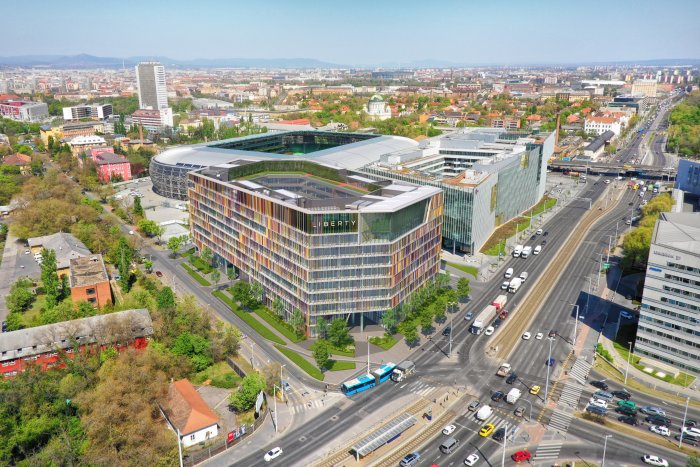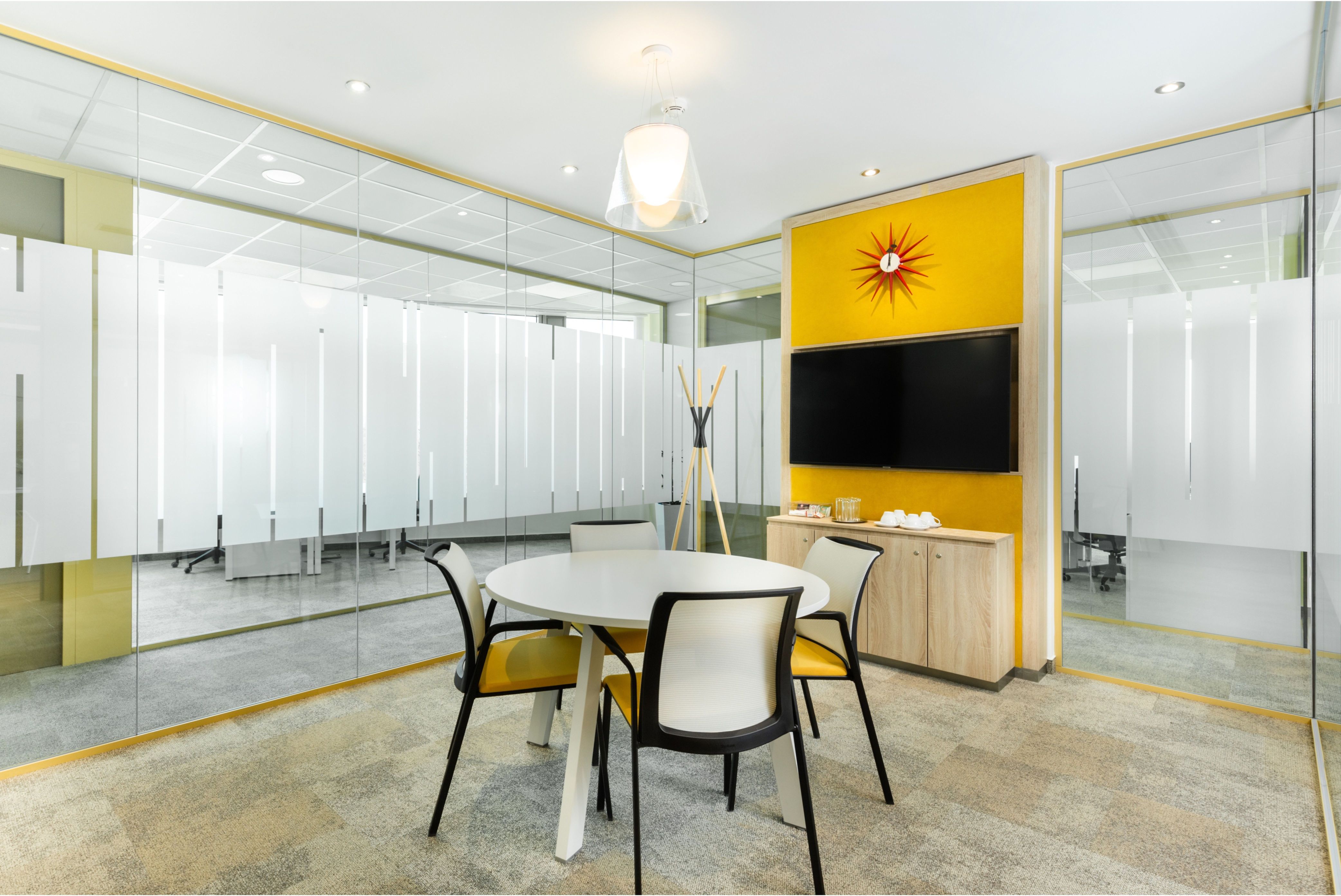Challenges of CBD Development Lead to Multiple Budapest Office Districts

The phased 38,000 sqm Liberty office complex is being developed by Wing near the junction of Könyves Kálmán körút and Albert Flórián út, in District IX.
One of the significant challenges for office developers in Budapest is to source suitably-sized development plots with direct public and private transport links that provide visibility. All this at a time when competition for such space in a relatively compact city is becoming more intense and consequently more expensive.
The additional difficulty of sourcing plots in the historic center and the resulting lack of an established Central Business District means developers are undertaking projects in several slightly out-of-center and suburban locations. Critically, these provide direct transportation links and are integrated into the wider urban environment, providing direct access to shopping, hospitality, and other facilities for office users.
As a result, Budapest has several business districts across the city on both the Buda and Pest sides of the river.
“The principles of sustainability in terms of location is pretty simple: an urban office district is best located when easily and quickly accessible from residential and retail areas, and there are means of public transport that support commuting back and forth to these destinations, all while being cost and energy-efficient,” comments Máté Galambos, director of leasing at Atenor Hungary.
The Váci Corridor is, arguably, still the most favored office development destination. The area is a model example of how a local authority, in this case District XIII, can attract developers to a post-industrial environment with brownfield sites (crucially here providing direct access to the M3 metro) and develop the location into a leading business district with relatively easy access to and from residential areas.
In a recent delivery in the Váci Corridor, Skanska has completed the first 27,000 sqm phase of the 67,000 sqm H2Offices, the development located on the plot of the demolished former headquarters of Budapest Waterworks. A second 22,000 sqm phase of the project is due to be delivered in late 2024.
Also in Váci út, GTC delivered the 27,500 sqm Pillar office complex last year. Further south but still on the same road, the developer is constructing the 70,000 sqm CenterPoint and refurbishing the 30,000 sqm CenterPoint 1 and 2 buildings.
Although Pillar and H2Offices are located in green environments in the upper reaches of the Váci Corridor, one critique is that Váci ut should have been redesigned as an avenue, with more green areas rather than remain as a dual-carriageway, as is currently the case.
Strongest Activity
In the first quarter of 2023, the strongest occupational activity was recorded in the Váci Corridor, with it attracting 31% of total demand according to the Budapest Research Forum (BRF), consisting of CBRE, Colliers International, Cushman & Wakefield, Eston International, JLL, and Robertson Hungary. The Central Pest submarket took second place with 23%, followed by Central Buda at 15%.
The outer boulevard of Hungária körút is also developing into an office hub. In District VIII it is home to the 72,000 sqm Aréna Business Campus, which is being developed in four phases by Atenor. Wing, meanwhile, is set to deliver the phased 38,000 sqm Liberty office complex, further along in District IX where the boulevard becomes Könyves Kálmán körút, and near the junction with Albert Flórián út. Both complexes are located at road, metro and tram junctions.
“South Pest and South Buda still offer several suitable locations in Budapest. I would like to underline the attractiveness of Könyves Kálmán körút in District IX, where we developed the Telekom headquarters. Owing to its excellent location, we are developing a new project next to it, namely the aforesaid Liberty,” says Noah Steinberg, chairman & CEO Wing.
“The location has many advantages, with a range of dining and cultural facilities within a few minutes’ walk of the building. In addition, the area has recently undergone significant development, and other ambitious projects are underway, which will continue to enhance the prestige of the neighborhood and Liberty,” he insists.
Galambos argues that Atenor has become something of a trendsetter in the Budapest office market by developing in what were previously unrecognized office locations, such as the southern part of the Váci Corridor.
Waterside Opportunities
South Buda can offer waterside development opportunities, a prime example being BudaPart by Property Market on a 54-hectare site on the banks of the Danube at Kopaszi Gát [Dam]. The project includes office, retail, leisure, hotel and residential components in addition to large park areas and is based on the concept of developing a new city quarter, whereby a person can access all their basic day-to-day needs within a 15-minute walk. Most recently, Property Market has delivered the 8,000 sqm BudaPart Downtown office.
Projects are now being developed on the Central and Southern Buda banks and across the river on the Pest side of the Danube. Such prime sites overlooking a river would be extremely challenging to source in many European capitals.
As mentioned at the top of this article, Budapest lacks a defined CBD due to the lack of large, well-located development plots. That is further compounded by the understandable priority the city planning authorities put on protecting listed buildings, meaning the planning process in the historic center can be protracted.
One option is to redevelop existing quality buildings, and there are certainly several listed properties within the CBD in need of renovation. Europa Capital purchased the riverside Akadémia Business Center, in partnership with ConvergenCE acting as the asset manager, in early 2022 and has redeveloped it into the 10,500 sqm Academia office center.
Developers like Wing and the French investor Groupama Gan REIM have also completed acquisitions of historic buildings in the CBD, a development vehicle that was arguably pioneered by Horizon Development with its Eiffel Palace (2013) and Váci 1 (2016) projects.
“As an international sustainable urban real estate developer, renovation seems like the most attractive option for us for many reasons. Renovation does not always present itself as the most financially beneficial solution, but it is, without a doubt, one of the most sustainable ways of property development,” Galambos agrees.
“We have beautiful historical buildings in the CBD of Budapest, most of them with amazing façades, which is why I personally believe that taking on the noble responsibility of a CBD refurbishment project, where some of the structural elements are saved, and the heritage-protected elements of these buildings are adequately reinstated, is not only a really smart thing to do but also the most forward-thinking in our current climate,” he concludes.
This article was first published in the Budapest Business Journal print issue of May 5, 2023.
SUPPORT THE BUDAPEST BUSINESS JOURNAL
Producing journalism that is worthy of the name is a costly business. For 27 years, the publishers, editors and reporters of the Budapest Business Journal have striven to bring you business news that works, information that you can trust, that is factual, accurate and presented without fear or favor.
Newspaper organizations across the globe have struggled to find a business model that allows them to continue to excel, without compromising their ability to perform. Most recently, some have experimented with the idea of involving their most important stakeholders, their readers.
We would like to offer that same opportunity to our readers. We would like to invite you to help us deliver the quality business journalism you require. Hit our Support the BBJ button and you can choose the how much and how often you send us your contributions.









